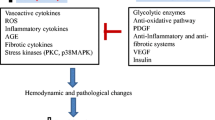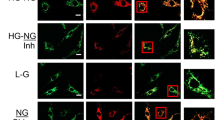Abstract
Hyperglycemia is one of the major underlying factors in the development of retinopathy in diabetes. Retinal microvascular cells undergo accelerated apoptosis before other histopathological changes are detectable in diabetes. We examined the effect of re-institution of good metabolic control (GC) on the activation of retinal apoptosis executor enzyme, caspase-3, and nuclear transcriptional factor NF-kB. In streptozotocin diabetic rats, two or six months of poor metabolic control (PC) with glycated hemoglobin >11.0% was followed by seven additional months of GC (glycated hemoglobin <5.5%). Caspase-3 activity in retina was measured by the cleavage of its substrate, the expression of active 17 kD subunit, and cleavage of poly(ADP ribosyl) polymerase. NF-kB activation was determined by electrophoretic shift assay and by western blots for P65 subunit. Caspase-3 activity in diabetic rats kept in PC for 13 months was 175% that in normal rats. Re-institution of GC after two months of PC partially normalized the hyperglycemia-induced activation of caspase-3 (to 140% of normal values) while re-institution of GC after six months of PC had no significant effect on the activation of caspase-3 NF-kB activity was 2.5-fold higher in diabetic rats kept in PC than in normal rats. Re-institution of GC after 2 months of PC partially reversed this increase (X-fold over normal), but GC after 6 months of PC had no effect. Initiation of GC soon after induction of diabetes in rats prevented activation of retinal caspase-3 and NF-kB. These results suggest that the process of activation of apoptosis execution enzyme and NF-kB in retina that starts before appearance of histopathological changes is not easily reversed by re-institution of GC. Characterization of the abnormalities responsible for the resistance of retinopathy to halt after re-institution of GC will help identify potential therapies for inhibition of progression of diabetic retinopathy.
Similar content being viewed by others
Author information
Authors and Affiliations
Corresponding author
Rights and permissions
About this article
Cite this article
Kowluru, R.A., Chakrabarti, S. & Chen, S. Re-institution of good metabolic control in diabetic rats and activation of caspase-3 and nuclear transcriptional factor (NF-kB) in the retina. Acta Diabetol 41, 194–199 (2004). https://doi.org/10.1007/s00592-004-0165-8
Received:
Accepted:
Issue Date:
DOI: https://doi.org/10.1007/s00592-004-0165-8




